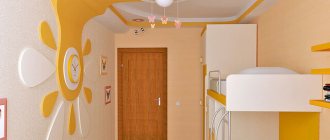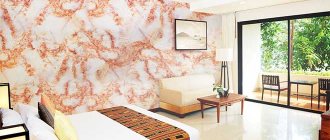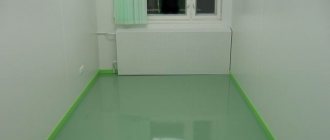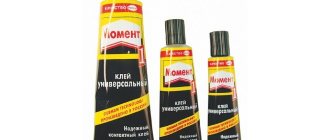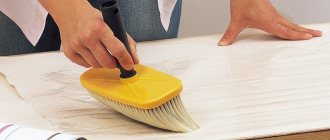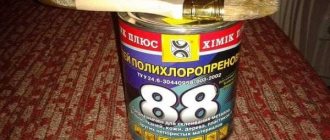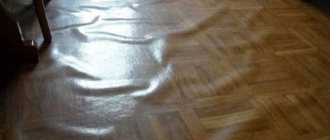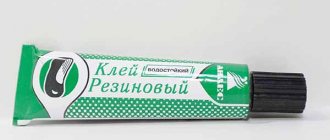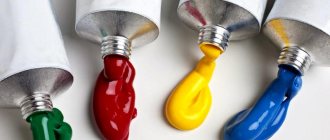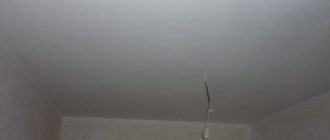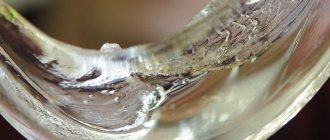Famous brands
- DecArt is a universal composition; it is distinguished by a white tint in its finished form; after complete drying, the layer becomes transparent. Used for connecting various surfaces, except polyethylene.
- VGT is a water-dispersible type, connects smooth surfaces with low absorbency, suitable for polyethylene.
- Polax is a mastic based on acrylic water dispersion, used for laying slabs, laminate, etc.
- ASP 8A provides a durable layer that resists aggressive substances while maintaining all properties.
- Axton is a universal product and is used for fastening wooden, plaster, and polystyrene elements.
- Rainbow-18 serves as a fastening base for all facing materials, as well as plasterboard, wood, concrete, etc.
- MasterTeks is an acrylic-based adhesive-sealant, used for reliable sealing of various materials, suitable for indoor and outdoor use.
Popular brands
There are different sealants in stores, the most popular are the following compositions:
- “Universal” from Novbytkhim. An inexpensive product based on acrylate dispersion and mineral filler. After drying, it forms a moisture-resistant, rubber-like white seam that does not turn yellow over time. The sealant is non-toxic and can withstand temperatures of –30…+70 degrees. Designed for repair work indoors and outdoors.
- Zigger Acryl. Plastic, elastic means for compacting various substrates. Includes a freezing point depressant additive. It is thixotropic and can be applied to vertical bases and ceilings.
- "Moment Acrylic Universal". It is used for strengthening and sealing cracks and crevices in windows, for sealing joints between plumbing fixtures and floors and walls. Can be applied to the junctions of metal sinks and walls, countertops in the kitchen. Retains properties at temperatures of –50...+150 degrees, is neutral with respect to alkalis, oils, and remains durable for several years.
- Belinka Beldom Acryl. Acrylate sealant that is suitable for all building materials. Sufficiently elastic, withstands deformation within 5–10%! Does not wear out, is resistant to sunlight and weathering.
- Loctite PL-S50. Universal frost-resistant composition based on acrylic water dispersion. Designed to strengthen weak joints between concrete, brick, wood, plaster, and ceramics. Ideal for grouting cracked surfaces. Suitable for painting and plastering.
- Makroflex FA. Freeze and thaw resistant sealant. Suitable for external and internal work. The seam can be painted an hour after drying. Can be used for all types of seams with slight deformation and stretching.
- PENOSIL Premium Acrylic Sealant. A universal water-based acrylic composition used for filling joints and cracks in low-moving joints. It is odorless, easy to apply, and after drying it can be sanded and coated with paint or varnish. It is quite moisture resistant and can easily withstand contact with water 5 hours after use.
We recommend: Bustilat glue - types, characteristics and application features
There are other acrylic-based sealants in construction stores: Titan, Krass, Master Tex, Pufas, Kim Tek and others. There is no need to save money and buy the cheapest composition. Products from well-known brands are of consistently high quality and highly effective. Working with acrylic sealants is easy and convenient; they will become reliable helpers in the home and on construction sites.
Adviсe
The main requirement when using acrylic glue is compliance with safety precautions, even if it is a harmless composition.
- The presence of personal protective equipment is mandatory when working with this substance.
- Surfaces requiring gluing should be prepared for application of the composition, dust, dirt and other contaminants must be removed, that is, the old finish should be cleaned and thoroughly degreased with alcohol or solvent. Sometimes using a primer is acceptable. In addition, the parts to be glued must be dry and dense, and not contain poorly secured elements. The glossy surface is treated with fine abrasive.
- Work is carried out at a temperature of +5º – +35ºС, excluding direct sunlight.
- The dry mixture must be diluted in strict accordance with the instructions, preferably with water at room temperature.
- Excess mixture that appears on the surface should be immediately removed with a dry cloth, otherwise after drying the glue will be very difficult to wash off.
How to use acrylic glue is described in the video.
How to choose?
When choosing a product, you should take into account the place of application and purpose of the glue. A universal composition in the form of a suspension is suitable for everyday use. It has a wide spectrum of action and is distinguished by a convenient release form and ease of application.
In addition to the intended purpose, installation conditions should be taken into account
When using the composition in conditions of low temperatures, you should choose a frost-resistant adhesive, and when installing in damp rooms, a water-resistant one. The next selection criterion should be the release form. If gluing smooth substrates is expected, the consumption will be much less than when working with porous surfaces, such as carpet or concrete. Therefore, if you plan to glue soft absorbent or cellular bases, you should choose a larger container.
Acrylic glue is deservedly very popular and has many positive reviews. Consumers note the high adhesive qualities and low cost of the compositions, the durability of the formed joint and the transparency of the seam
Attention is drawn to the waterproof properties of the glue and the possibility of its use as a sealant. Buyers even note some superiority of acrylic compounds over silicone ones and more often choose them
One of the negative properties is that the glue sets too quickly, which makes it impossible to correct unevenly located parts. In general, there are much more positive reviews, which indicates the high consumer demand and versatility of acrylic products.
A video review of universal acrylic glue awaits you in the video below.
Types of compositions
Now you need to understand what types of acrylic glue there are. First of all, it is divided into one-component and two-component. In the first case, the composition is completely ready for use. In the second, it must be diluted with another component - a catalyst.
Additionally, acrylic-based adhesives may be classified differently. For example:
1. Cyanoacrylic. It is considered the safest, as it does not contain solvents. At the same time, it sets very quickly. Most often, such adhesives are one-component. The composition can be used to connect small plastic, metal, leather or rubber parts.
2. Modified. It is most often two-component. That is, before you apply glue to the surface of the workpiece, it must be coated with an activator. Sometimes both components can be pre-mixed.
3. Ultraviolet curing. This glue is used to join glass or other transparent products. It hardens under the influence of ultraviolet waves of a certain length. However, the fixation of objects quickly occurs only in the place affected by the rays.
4. Latex-based glue. It can be used in any conditions. At the same time, it will serve properly for a long time and is safe for health.
5. Water-based acrylic dispersion adhesive. It is basically two-component. This composition has fairly high adhesion and is environmentally friendly. This glue hardens only after the water contained in the product evaporates.
6. For tiles. Moreover, this facing material can be attached both to the floor and to other areas. This adhesive holds the tiles well, is easy to apply and adheres to almost any substrate.
Glue Acrylit 43 Liquid tape
For gluing a wide variety of surfaces, including inert (passive) ones. Has the highest residual stickiness and adhesion.
Application area
“Liquid tape” is used for gluing a wide variety of surfaces, including inert (passive) ones. It has the highest stickiness and adhesion. The adhesive is used for interior work. Designed for gluing products made of ceramics, cork, wood, paper, cardboard, fabrics, as well as for gluing mosaics, type-setting linoleums (both on a woven and non-woven basis), polystyrene foam and polyurethane coatings on ceilings and walls. Can be used both on the facade of buildings and inside, as well as when finishing metal ventilation ducts; facilitates the installation of soundproofing and heat-insulating panels.
Properties and features:
- does not contain plasticizers and does not destroy the working substrate;
- after drying, the adhesive layer becomes transparent and sticky;
- stickiness remains for a long time;
- completely environmentally friendly and fire and explosion proof.
Compound:
Aqueous dispersion of acrylic copolymer, modifying additives.
Application method
“Liquid tape” is applied with a brush, roller (or poured automatically) in a continuous layer or dotted. The criterion for complete drying is the change in color of the glue from white to colorless. After this, the surfaces to be glued must be aligned and pressed for a few seconds. Considering the constant stickiness of contact glue, the surfaces to be glued can be opened and glued again. However, this leads to a decrease in adhesion. To increase the strength of the seam, it is recommended to apply glue to both surfaces to be glued. Drying time is approximately 1 hour under normal conditions. If applied in thick layers or on rough surfaces, or in low temperatures or high humidity, drying time may increase.
Glue Acrylit 43 Liquid tape
Working with glue
How to use silicone adhesive? There will be no difficulties in repairing various products; even a beginner can handle it. But labor efficiency will depend on the quality of foundation preparation
It is important that the base is dry, clean and smooth. It must be degreased before work, this will help improve the quality of adhesion
You can degrease the surface using any suitable means - a cleaning solution, a special composition. After degreasing and drying, the edges of the joints can be covered with paper tape, this will avoid blemishes and blots, and the layer will be applied evenly.
Next, the operating procedure is as follows:
- cut off the spout of the glue, if it is sold in a small tube, or open the cap (it is better to use a special dispenser for glues, it will not allow excess product to escape);
- when working on a large area, it is worth purchasing a glue gun;
- apply the material to one of the surfaces to be fastened and fix them or lay an adhesive seam;
- surfaces should stick within 10-30 minutes, as indicated in the instructions;
- The product can be fully used after a day, during which time polymerization will occur.
Increasing the room temperature by 5 degrees above room temperature speeds up polymerization by half. An adhesive layer thickness of more than 20 mm does not make sense, since the product will not harden deep in the seam. Excess glue must be removed immediately with a cloth or spatula.
Variety of types of adhesives
The company's arsenal includes not only glue and various adhesives. The brand produces technical compounds that provide protection and support the functioning of mobile devices.
Screw sealing
Such products are available in the form of liquid solutions. Also on sale are tapes that provide sealing of screw connections. These substances get into the space between the threads, forming an impermeable layer. Loctite sealants help prevent fittings from coming loose. They prevent leakage of technical substances. Screw sealants have the following characteristics:
- withstand prolonged exposure to high or low pressure;
- do not crack during temperature fluctuations;
- have excellent adhesive characteristics, allowing metal and plastic to be attached;
- are produced in the form of one-component solutions or sealing tape;
- do not shrink;
- provide protection against corrosion;
- are not subject to dissolution by alkalis, gasoline and oils.
Flanged sealing
When applied, such substances polymerize, forming a sealed seam between the elements. It appears in the gaps between parts. Such products protect devices from liquid leaks. They also allow you to avoid losses of technical gases. In addition to the sealing layer, the substances create a coating that protects the surface from corrosion.
The following features are characteristic of flanged substances:
- do not react to the influence of reagents and technical gases;
- do not crack under significant temperature fluctuations;
- do not suffer from pressure fluctuations;
- are produced in the form of silicone and anaerobic solutions;
- are not subject to shrinkage and expansion;
- anaerobic compounds provide rigid adhesion, silicone compounds are used for moving elements;
- due to its liquid consistency, it fills microscopic holes and cracks, independently distributing over surfaces;
- do not require additional tightening of the thread;
- help replace gaskets made of other materials.
Elastic industrial seals
Such means help protect the elements of mechanisms from the influence of harmful factors. They protect parts from high humidity, air, and gases. The substances also protect against solid elements.
The following features are characteristic of such funds:
- in case of deformation, the seals restore their shape;
- are produced in the form of one- or two-component liquids;
- have excellent adhesion to different materials - they may differ in density or texture;
- do not crack at low temperatures;
- are not subject to destruction by water, ultraviolet radiation, or exposure to air;
- are characterized by high vapor permeability.
Kinds
Adhesive polymer mixtures differ from each other in some components that are included in their composition.
All modern compounds are divided into three main groups.
- Adhesives based on urea-formaldehyde resins, polyurethane and epoxy resin.
- Water-based mixtures. This glue can be diluted with water. This group includes PVA and bustilate (synthetic latex wallpaper adhesive).
- Compositions that can be diluted with organic solvents. This type includes nitrocellulose (nitro glue), rubber glue and a mixture based on perchlorovinyl resin.
Depending on the technical characteristics of a particular type of polymer adhesive, its scope of application is determined.
Let's look at the main types.
- Mixtures for indoor work. Used for cladding various surfaces.
- Adhesives for external works. This group includes compounds that are characterized by increased resistance to environmental influences and low temperatures. Only waterproof mixtures are suitable for outdoor work.
- Universal mixtures. This composition is suitable for gluing most types of materials and can be used both indoors and outdoors.
- Mounting solution. It features high performance characteristics. Using this glue, you can glue even massive products to various surfaces.
- Glue "Liquid nails". The composition is characterized by low consumption and quick drying. Quickly and reliably fastens a wide variety of materials together.
- “Cold welding” mixture. It is a transparent gel-like mass. The peculiarity of this modification is that with the help of such a tool you can carefully and imperceptibly connect the broken pieces of an object to its base.
Description and purpose
The adhesive mixture of the French company KLEO is developed for high-quality application of wallpaper on walls. The company is considered the best in the construction market, offering high-quality and affordable products. A large assortment makes it possible to choose the desired composition that is suitable for the selected type of wallpaper.
In order to avoid disappointment from the work done, you should approach the choice of materials responsibly. Cleo wallpaper glue comes in several types: for non-woven, paper and photo wallpapers. Professional craftsmen most often use glue for glass wallpaper.
The adhesive mixture is sold in a package of 250 g. The powder is protected by two sealed bags and a cardboard box, which prevents moisture from penetrating inside. The glue is diluted immediately before gluing the wallpaper to the wall yourself.
The main feature of Cleo is its ease of application and ease of use. After the adhesive-based solution has completely dried, there are no foreign odors or stains left, and the walls are protected from the development of fungi and mold. The prepared solution can be stored for 10 days in a hermetically sealed container.
Material characteristics
When shoes are worn for a long time, the sole often comes off. This is due to the rupture of the nylon threads with which it is sewn. In repair shops, for restoration they use nairite (shoe) glue - a one-component material. Chloroprene rubber (nairit) is used in its production. It looks like a translucent resin, its color is light yellow. Also contains:
- organic solvents;
- iron salts;
- chlorinated polymers;
- vulcanizers.
The glue can be used to process seams on shoes - it is water-repellent and prevents the product from getting wet. After the film dries, no toxic substances harmful to humans remain. At the same time, the sealing of the gluing area is excellent. Typically, adhesives of this type are sold in large containers, but many brands are available in small tubes. Shoemakers prefer products from Poland and Italy. Much cheaper, but lower quality compounds made in Turkey.
Here are the main characteristics of Nairite glue:
- share of non-volatile components – 24%;
- density – 0.85 g/sq.m. cm;
- delamination index – 62 N/cm during the day;
- maximum opening time – up to 65 minutes;
- achieving maximum strength of the adhesive layer – 190 minutes;
- heat resistance – 75 degrees.
Types and properties of polyurethane glue
Before using a sealant, you need to familiarize yourself with the distinctive features of its varieties.
One-component
A one-component polyurethane adhesive is a synthetic mixture made from isocyanates. Outwardly, it looks like a thick and viscous liquid, which is colored gray with a slight whitish tint. To make the adhesive composition more viscous, a little acetone or other solvents can be added to it. The stickiness of the glue is increased by adding synthetic resins.
One-component mixtures are sold ready-made. Their hardening begins after contact with water. Hardening may also begin if air humidity exceeds 65%. Before using a one-component product, this feature must be taken into account.
Two-component
From the name of the glue it is clear that it contains two active substances at once. The first component is a combination of polyhydric alcohols with polymers. These microelements are responsible for the viscosity of the composition, elasticity and strength. The second component is a diisocyanate, which is used to dilute the product.
The two-component adhesive has a wide range of applications. The components included in its composition ensure high reliability of the connection. The initial grip of the glued components will not weaken even after decades. It is resistant to high humidity, high and low temperatures.
Types of glue for mirrors
What types of mirror glue are there? Reflection helps not only to see your beloved self in all its glory, but also to change the geometry of space. You can make the room wider or brighter. But what if you don’t want to make holes in the mirror?
Mirror glue Titan
Then there are several mounting options that allow you to place reflective glass on a wall, or, say, a door. Such compositions should not contain any acids, the same applies to alkali. If you try to classify them, then these are:
- solvent based binders. Here you need to take the time to read the label. It should contain an explanation that the selected product can be used not only for glass, but also for our purposes. There you can find substances that will destroy the amalgam over time, and your decor will become unusable. But there is also a plus - the price.
- on silicones. These are more expensive, but the quality will please you. They fasten securely. True, don’t expect an instant effect; it will take time for the surfaces to “set.”
- and combined.
Very often, stores offer “liquid nails” for purposes. They are divided into acrylic (their plus is safety. But! They will not withstand contact with water; high temperatures will also be detrimental to such a connection.
If you plan to attach the mirror to metal or tiles, look for another option, these will not cope with this task), and neoprene (synthetic rubber as the main component allows you not to worry about the reflective surface falling off the tile. But remember that you will have to put up with an unusually toxic odor during work).
Gluing cork panels
Cork panels
Before gluing the cork to the wall, you need to study the characteristics of the material and the composition of the glue used.
Cork panels come in the form of paper-backed wallpaper or slabs. You can glue them yourself. The main thing is to choose the right glue and carry out the work in accordance with the instructions. If the weight of the canvas is small and the surface is suitable, then we glue it with a water-based compound.
Water based glue is safe. But if the humidity in the room is high, then it is better to use a solvent-based composition
It is important to remember the toxicity of its composition and work in a respirator
The cork is pressed to the surface. Drying time is no more than 12 hours.
Table tennis glue
Bostik glue
Previously, organic glue was used for table tennis. It is currently prohibited. Water-based table tennis glue has a yellowish color and ammonia smell. After drying, a very sticky film appears on the surface.
Gluing order:
- Apply a little glue to the middle of the sponge.
- Level with a special brush or swab.
- Roll the overlay onto the board.
The consumption of water-based table tennis glue will be 2 times less. Rubber from such a composition does not curl up.
Glue for gold leaf
Gluing gold leaf
Potal is thin sheets of alloys. This material is used for silvering and gilding gypsum stucco, ceramics, plastic, cardboard, metal, wood, and glass. In order for the procedure to be done efficiently, you need to choose the right glue. The composition is used on different bases.
Water-based glue for gold leaf is used quite often. There are several varieties of this glue. For example, white Permacoll glue becomes discolored after drying. Paste is used to decorate surfaces without primer. Fine artistic work is done using glue in a tube, pencil or marker.
Potal
Water-based glue does not need to be diluted with water; it has the desired viscosity. After a layer of glue has been applied, gilding is carried out. You need to check the instructions on the package for the time. It is necessary to take into account the humidity and temperature in the room.
There are different brands of glue for gold leaf. The universal Ferrario compound is used to glue gold leaf. The composition "Tair" is used for transfer and free sheet metal.
Features of the use of acrylic sealants
No special knowledge or tools are required to apply the material. It is only important to carefully prepare the base: clean it from grease, dirt, peeling coatings, then dry it well. If the seam is thick and wide, it is worth purchasing a sealing polyethylene cord in advance or filling the joint with another sealant. This will make the connection more reliable, reduce thermal conductivity and reduce sealant consumption by 40–70%!
Acrylic can be applied even without using gloves, as it does not irritate the skin of the hands. It is strictly not recommended to dilute it with water or any solvent - this will reduce the quality and cause rapid cracking of the seam. For application, you can use a special gun into which cartridges and tubes are conveniently inserted. It is better to spread sealant from a jar or bucket with a small spatula; from a tube, simply squeeze it out, directing the thin spout to the desired place.
After application, the product can be given any shape within 10–15 minutes. Then a polymer film will begin to form and repairing the seam will be difficult and impractical. Curing of the sealant lasts 24 hours, but at low temperatures the process may take 2 days.
We recommend: What can be made from a glue gun and how to work with it correctly
To increase your work efficiency, you should consider the advice of professionals:
- if sealing is carried out in the bathroom, you must wait at least a day before using the surface, otherwise the top layer of the seam will blur;
- Do not touch the joint until it is completely dry: the surface film may be damaged;
- The humidity and temperature in the room cannot be changed until the polymerization of the sealant is completed;
- After opening the package, you will have to use the entire composition, otherwise during storage it may lose its basic properties.
What kind of jobs is sealant best suited for?
Acrylic is suitable for various jobs in everyday life, at construction sites, and in repairs, but it is optimal to apply it to low-moving or fixed joints that are not regularly in contact with moisture. Examples of work with this composition:
- repair of cracked furniture;
- restoration of parquet, laminate;
- linoleum gluing;
- installation and repair of doors, windows, balcony blocks;
- installation of skirting boards, baguettes;
- sealing tile joints.
Sealing tile joints with acrylic sealant
Consumption of funds
To calculate the required amount of sealant, you need to know the dimensions of the future seam. You can multiply the depth of the seam by its width, resulting in the approximate volume of product per meter in grams. If the joint is triangular rather than square, the final figure is divided in half. On average, 250 g of sealant is enough for 10 meters of not too thick seams.
Removing traces
It happens that the product gets on various surfaces in the house. It will not be difficult to remove it before it hardens: just wash the base thoroughly with soap and water. If the composition has hardened, you can use a sharp knife or razor. Remove the product layer by layer, cutting it off carefully so as not to damage the product. The remains are rubbed down with fine sandpaper, steel wool or pumice. Remove sealant from delicate surfaces with a wooden scraper. After finishing work, wash the item with soap and other detergent and dry it.
Uncured traces of sealant can be easily washed off with water.
What can you say about the final product?
The most popular acrylic resin product is artificial stone. It is used in different directions, as it has many positive qualities. The first thing worth mentioning is the chemical indicators. Artificial stone made from resin does not react to many chemical compounds, which increases its service life and increases demand in the market. This is exactly what acrylic resin manufacturers focus on.
As already noted, the use of such resins helps to completely eliminate the formation of pores. As a result, such a stone becomes hygienic. Bacteria do not grow in it and nothing multiplies on the surface. As a result, the scope of use is expanding not only on a production scale, but also in personal use.
Another indicator is maintainability. Since the stone is artificial, the appearance of chips or cracks on it is simple and easy to remove using sandpaper or a grater. Therefore, making any design from it or during the finishing process is profitable and simple. In addition, more serious damage is removed and a similar acrylic resin stone is inserted.
Many craftsmen believe that artificial stone made from such materials works well. It can be used to implement any projects of complex shape and configuration. Nothing will interfere - flatness and volume. You can find stairs, fountains, sculptures and the like made from acrylic stone. The most interesting thing is that a figure of any size can be assembled. To do this, the individual parts are glued together, and the joint is simply sanded. As a result, nothing is visible, as it turns out to be a monolith.
Acrylic resin is a unique substance. Therefore, as already noted, any color scheme can be created. As a result, when making building materials from it, the color is also selected. To do this, take the required pigment. Thanks to this, artificial acrylic stone can be found in any composition.
Acrylic adhesive ACRIFIX 190. What are its characteristics?
It is worth noting that ACRIFIX 190 is a 2-component MMA-based adhesive.
This means that it does not harden on its own. Please note that in order for this glue to harden, it must be mixed with a catalyst. In particular, they are 3-5% Catalyst 20. Among the characteristics of the glue, the following should be mentioned:
- quite viscous composition; colorlessness of seams;
- high bonding strength;
- in addition, it is weather-resistant (the glue does not react in any way to precipitation and other weather conditions);
- variable hardening time;
And I also need to add that this polymer glue has a 2-year shelf life.
Acrylic resin production
You need to know the manufacturers. There are many of them, because such masses are in demand. These are different countries:
- Tennants GmbH. Germany.
- VELOX GmbH. Germany, one of the best today.
- Federal State Unitary Enterprise Research Institute of Polymers named after. Academician V.A. Kargina (Dzerzhinsk, Russia). This product is in demand on the market.
- ELEKTROISOLA, Tabor (from Czech Republic).
- Suter Kunststoffe AG. From a Swiss supplier.
- GRUPA EXLAK. Poland produces equally high-quality goods.
But where is acrylic resin most often used? It is effective in the process of creating plastic masses. In addition, it is suitable for polymer composite materials: artificial stone and marble, fittings, decorative items, etc. Today this component is considered the most popular in the creation of self-leveling floors and paint and varnish compositions.
Advantages and disadvantages
CMC is diluted only with water at room temperature. No other substances need to be added to prepare the solution. The adhesive mixture is simple and quick to prepare. There are no toxic additives in it. The mass is homogeneous, colorless, without lumps and sediment. The adhesive mixture can be used in any room, even in a children's room. When dried, the solution does not release any substances that are toxic to the body.
The adhesive mixture itself, prepared from white powder and water, is colorless. It has no smell. Some manufacturers tint the powder pink so that the places where the glue is applied to the canvas or wall are visible. The adhesive solution ensures the wallpaper adheres to all types of surfaces. The main thing is to clean the wall from crumbling particles before repairing. CMC can be used even in rooms with high humidity.
Insecticidal and antifungal additives are added to the glue. For example, boric acid salt, aluminum-potassium sulfate, carbolic acid. Such substances improve the quality of the adhesive mixture and prevent fungi, mold, and insects from multiplying under the wallpaper.
CMC has disadvantages. This glue needs time to swell. Usually about 2-3 hours. Modern formulations have a shorter swelling period - only 15-20 minutes. True, the price of such products will be higher. After gluing the walls, you need to wait at least 3 days for the glue to dry completely. While the substance dries, there should be no drafts in the room. It is better to do the repair itself in the summer, so that the wallpaper dries naturally, without turning on electrical appliances.
Share link:
What kind of material is this?
It is known that cladding made of marble, basalt or sandstone has a decent thickness and weighs a lot. Accordingly, this material is quite difficult to install, although it is certainly very beautiful. Such tiles cannot be thin, since the material, despite its hardness, is quite fragile and requires careful handling.
Flexible stone material
There are 2 main manufacturing methods:
- The older method is made of sandstone. The latter is mined in quarries and a very thin layer is cut off from its surface. A section of sandstone is fixed to a fabric base, and then used as a facing material: glued to the wall like wallpaper. The cut is very thin, so it retains a certain flexibility. Acrylic glue is used to make flexible stone. This production technology is followed, for example, by the tile manufacturer Gliga Stone.
- There is another production method - from bulk materials. In this case, fine marble or basalt chips of a fine fraction are glued onto the fabric base. Using materials of different shades, textures and sizes, you can create patterned tiles with a fantasy design.
Method of gluing flexible stone
This manufacturing method is much simpler, and the resulting material is much more decorative. In addition, finished products can be painted. You can make tiles from crumbs with your own hands.
Decorating walls
In the video, the process of pasting with this interesting material is presented in detail.
Scope of application
The main area of use of the product is shoe repair. It can firmly bond leather to leather, artificial materials, nubuck, and shoe fabric. You can also connect the fabric base to the inside of the shoes, glue heel caps, and attach outsoles. It is acceptable to glue zippers instead of sewing them in.
Among other things, it is possible to use a means for fastening any parts from:
- rubber;
- wood;
- metal;
- felt;
- plastic;
- glass;
- ceramics;
- porcelain.
Using the material, you can stick construction decorations onto the base - moldings, plastic corners, tiles. The highest quality is produced in cans; it is this that connects the parts most reliably. Adhesives in tubes are used for those products that are subject to less friction and pressure (for example, boot tops).
Areas of use
Currently, emulsions based on acrylic fiber are successfully replacing other types of adhesives. It is successfully used both at home and in production. To combine different textures, separate types of compositions have been created that have their own characteristics. So, to obtain a transparent seam, a seam that hardens when the acrylic structure is exposed to UV rays is used. This technology is used when gluing glass and other transparent surfaces.
Small plastic, leather parts or small rubber surfaces can be joined using a one-component cyanoacrylic compound. It is absolutely safe and can be used at home.
Application of acrylic glue
The use of water-soluble emulsion glue is also quite wide. These include wallpaper mixtures and solutions for gluing tiles and parquet and other interior finishing works. An important advantage is that there is no need to carefully level the surface before application. The high adhesive properties of acrylic compounds make it possible to obtain a strong connection even when connecting rough surfaces!
Important! Before connecting surfaces with different textures, you need to read the instructions and find out their compatibility!
Specifications
Acrylic glue is produced in several variations. Each has its own properties and purpose.
There are masses with one- and two-component composition. Single-component ones are suitable for use, as they do not require additional preparation, the mass is ready for use. Before use, two-component formulations are diluted to the desired state with water. The readiness of the mass is determined by its liquid consistency, colorlessness or yellowish tint.
The consumption of acrylic substance is in the range of 150–500 grams per m2. This indicator depends on the structure of the plane being glued, its preparedness, and the type of mass.
Each brand has its own tensile strength; it can be from 5 to 25 kg per cm2.
The time for complete drying depends on the conditions created and the type of glue. It can take from 10 minutes to two days.
Use is not recommended at temperatures below 7 degrees.
Compound
The basis for the production of acrylic adhesives is acrylic resin and various additives. A positive feature is the absence of solvents in the composition, which create a strong odor and are dangerous to the body. They have been replaced by organic compounds, which include aromatic, chlorinated hydrocarbons. These elements quickly evaporate when dried, do not contain toxins, and do not affect the body.
Plasticizers, fillers, additives, and thickeners are added to acrylic adhesive. They are needed to reduce shrinkage, flexibility of the material, for ease of working with the mass, and to impart additional properties.
Release form
Acrylic glue is produced in two versions: ready-made and dry. The second type is packaged in bags of 1–25 kg. To obtain the finished solution, add water and stir to the desired consistency. The finished mixture must be consumed within half an hour, so you should not prepare a large volume at once.
The finished version is used immediately after opening the container. Large volumes are produced in cans and barrels, small volumes in tubes.
Interesting video on the topic:
Purpose
This product is produced for work in the construction, repair and installation industries. Acrylic is suitable for joining dissimilar surfaces, even with an uneven base. Suitable for connecting ceramic, mirror bases, flexible stone, gluing linoleum, carpet, foam plastic, etc. It also perfectly connects wood, MDF, chipboard, laminate.
Since there are no toxic compounds, work can be carried out in living rooms.
Acrylic glue - what is it?
Acrylic glue is characterized by its ability to dissolve in water. Its constituent elements are considered safe for human health; no diluents are added to it. It looks like a liquid solution, it can be transparent or have a yellowish tint.
Its constituent elements are considered safe for human health; no diluents are added to it.
Composition and technical characteristics
The substance is based on acrylic resin, to which other elements are added. Instead of harmful solvents, the composition uses organic compounds (chlorinated or aromatic hydrocarbons). These substances do not emit an unpleasant odor, and their evaporation is harmless and non-toxic. Also, to improve the quality of the glue, the addition of plasticizers, fillers, additives and thickeners is used.
The compositions may differ in characteristics. One-component options are considered ready-made, while two-component options should be mixed with water before repair work.
Acrylate glue has a low consumption, the average is 150-500 grams per square meter. The indicator varies depending on the quality of the surface, its type, and the composition itself. The time required for drying also depends on several factors: the type of adhesive solution; environment.
Acrylate glue has a low consumption, the average is 150-500 grams per square meter.
Advantages and disadvantages
Like any product, acrylic glue has its positive and negative sides. To decide whether glue is suitable for a particular type of work, you need to understand this aspect. Benefits include:
- Lack of toxic elements, safety for humans;
- Copes with fixing different surfaces, creating a reliable connection;
- The consistency of the composition allows it to be applied to different surfaces, leveling out imperfections;
- Waterproof, which makes it possible to use it as a sealing solution;
- It tolerates the effects of various environmental factors well, which allows it to be used for outdoor work;
- Variety of options presented;
- Acceptable price;
- Transparency.
The disadvantages are:
- There is an unpleasant odor during operation;
- Fast hardening time, which does not allow for correction of defects;
- Thin seam of gluing.
The consistency of the composition allows it to be applied to different surfaces, leveling out imperfections.
Main characteristic indicators
Acrylic resin is a type of acrylic plastic, but with a modified composition and quality. Thanks to this, pores do not form in the original product. The absence of monomer is observed after polymerization. If we compare acrylic resin with other similar components, then it has the least amount of chemical additives. In addition, the curing speed is higher. This allows you to quickly work on creating the final product.
Experts believe that the shelf life, as well as the spectrum of use of acrylic resin, may be different. There are also artificial substitutes. There are many domestic and foreign suppliers of these products on the market. From this we can summarize the positive aspects of the material and display them in single indicators:
- The absence of styrene indicates complete safety and environmental friendliness.
- Residual monomer is minimal (the material is non-toxic).
- The shelf life is longer compared to other similar materials.
- Physico-chemical indicators are high.
- When purchasing, you can get a discount on the product.
Popular varieties
There are five popular types of glue that are used most often.
"Nairit-1"
Nairit-1 glue is considered high-quality and effective. Its main advantage is considered to be a flexible adhesive seam that does not deteriorate even when exposed to low temperatures. “Nairit-1” is recommended for shoe repair.
Sar-30E
This is an Italian adhesive that is considered by many to be the best rubber adhesive. The product is distinguished by its versatility, as it is suitable for gluing many materials. It can be used to glue heels, insoles and rubber soles. Sar-30E hardens quickly, within two hours.
"Rapid 5"
This is a Russian adhesive that is often used to repair shoes. The popularity of Rapid-5 is due to its low cost compared to foreign analogues. This glue is made from a rubber mixture that firmly bonds metal, rubber and plastic.
"Anles"
This adhesive mixture, like Rapid-5, is produced in Russia. "Anles" is most often used to glue shoe soles made of synthetic fabric or genuine leather. When using such a product, it is recommended to use the hot gluing method.
"Nairit 88P-1"
People who want to use high-strength glue should pay attention to Nairit 88P-1. The advantages of the product include:
- strength of the adhesive seam;
- resistance to temperature changes;
- moisture resistance;
- quick drying.
Properties of quality material
According to European standards, the following properties of a reliable composition are distinguished:
- the composition should retain its qualities from one to four hours;
- the standard composition is not covered with a film within twenty minutes, quick-drying - within ten;
- the surface after applying the composition should not slip (maximum - half a millimeter of slip).
When purchasing, pay attention to the codes printed on the packaging:
- C1 (regular remedy);
- C2 (improved remedy);
- C2S (can withstand deformation);
- E (can be kept open);
- F (hardens quickly);
- T (no creeping effect);
- G (liquid).
What can glue
There are fourteen materials that can be glued using nairite glue.
Skin to skin
Experts recommend using an adhesive to join leather surfaces. It adheres to the skin due to its elasticity and fast drying speed after application to the surface. The bonded surfaces do not lose their elasticity after treatment with liquid, and therefore the connection is considered reliable.
Artificial materials
An adhesive composition made from rubber is suitable for gluing artificial materials. These include the following:
- Polyethylene. This is a common material used for making packaging products.
- Polystyrene. Polystyrene sheets are used in the construction industry for insulation of premises. When attaching them to surfaces, they use nairite glue.
Nubuck
This is a common material used in the manufacture of furniture and shoes. The following types of nubuck can be glued using glue:
- Natural. Used in making shoes.
- Artificial. It does not allow air to pass through and is therefore used to create furniture.
Shoe fabric
Fabrics used in the footwear industry are particularly durable and of high quality. Some of them are glued together with nairite glue when making shoes. Such materials include:
- Matting. Closed shoes for children and summer shoes are made from it.
- Felt. Woolen material used to insulate shoes.
- Calico. Inner insoles are made from it.
Heel caps
All shoe heels have special heels that make them more durable. These products are made from different materials:
- plastic;
- wood;
- rubber;
- metal.
Such products are attached in various ways, but adhesive mixtures are most often used.
Holds a candle
The outsole is the part of the sole that ends near the heel. It is installed to make the shoe sole stronger. Waterproof nairite glue is used to attach the outsole.
Rubber
Rubber is an elastic material made from natural rubber. Rubberized products are often used in the production of furniture structures or shoes. To attach rubber to surfaces, it is better to use nairite adhesive mixtures.
Tree
Wood materials are distinguished by their versatility, as they are used in various fields of activity. Most often, wood is used in the manufacture of furniture. For fastening small wooden components, it is better to use adhesive mixtures.
Metal
Many people believe that metal products need to be secured with screws or strong bolts, but this is not always the case. If the iron structure or part is not very heavy, it can be attached using a rubber-based adhesive.
Felt
This is a common fabric material that is made from sheep wool. It is used to create handbags or clothing items. It is also used in the manufacture of furniture elements. To attach felt, not only threads are used, but also nairite glue.
Plastic
Plastic is a modern polymer material that is characterized by a high level of elasticity and strength. Today this material is popular, as many different objects are made from it. To attach plastic to something, rubber adhesive is often used.
Glass
Sometimes people have to deal with gluing glass. Most often, this need arises if it is necessary to install a glass insert on the door. Nairite adhesive will help attach it to the structure.
Ceramics
Ceramics are dishes that are made from clay substances mixed with mineral components. Such products are highly durable, as they undergo a firing procedure during the manufacturing process. However, despite this, ceramic structures can break and will have to be glued together. Rubber glue will help to glue ceramic products.
Porcelain
Porcelain tableware is made from porous white clay to which feldspar and quartz are added. During the manufacturing process, the products are fired, making them moisture-resistant and waterproof. If the porcelain is broken, it can be glued together with nairite adhesives.
Types of adhesive compositions depending on the components
Adhesive compositions have different compositions. There are six subtypes of acrylate glue. The constituent elements influence the resulting properties and characteristics of the species. Cyanoacrylic mixtures are a universal product that can be used for most types of materials. Safety and toxicity make it possible to use it to glue children's products, and it is also convenient to glue surfaces during indoor renovations. The downside is that the product dries too quickly. Suitable for plastic, metal, rubber, leather and more. It is also used in medicine.
With additives, other elements are added to the acrylic base to obtain more varied properties. Plasticizers are used as standard, they become more flexible and hardening occurs faster.
Solvents can also be added, which themselves are toxic, so the rules for working with them require compliance with safety measures.
Acrylic water-dispersion adhesive consists of two components. It has the best fixing characteristics and is universally applicable. Therefore, they are also used as acrylic mounting adhesive; their fixation resistance allows them to reliably glue objects together outside and inside. It is most often used for gluing wooden, plasterboard, ceramic and plywood products.
The composition of ultraviolet curing is different in that drying occurs only under the influence of ultraviolet light. Suitable for gluing glass and metal parts. They are not used for wood.
They have a high resistance to moisture.
Special versions of acrylic compositions are created for tiles. Suitable for materials such as: artificial and natural stone, ceramics, granite, marble chips. With the addition of an elasticizer, it can be used for plasterboard, wood and chipboard structures.
